
Riglos, famous for the utterly outrageous Fiesta de Los Biceps, a swathe of heavily chalked, perma-dry conglomerate "potatoes" (visible from over a mile away) which breaches the steepness of the Visera tower, has a lot more to offer than the average passing climber gives it credit. When the nearby tufa paradise of Rodellar is suffering from seepage (or just simply for a change of scene), climbers flock to the 300m orange towers for something a little different, and Riglos is certainly that.
Although there are some single pitch offerings at the base of El Puro and El Pison, the main attractions are the longer routes.
The conglomerate rock offers up holds unlike anywhere else in the world, pebbles, rocks and blocks varying from the size of a tennis ball to that of a microwave (a bolted microwave naturally, not just one bolt either). Anywhere else, pulling on these holds would feel like pure madness yet they're surprisingly well attached (for the most part).
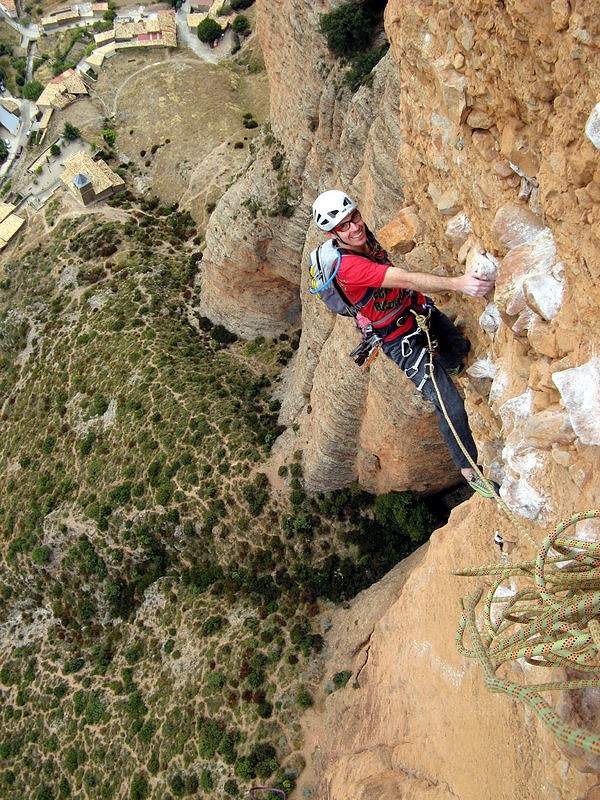
Given the nature of the rock it'd be quite easy to believe that each route would essentially climb the same (one potato, two potatoes etc.), yet each tower has a distinctly different characteristic, from 45m stamina pump fest pitches to bouldery roofs and of course, the ferocious steepness of the Visera.
It's not just about steepness though, Normal route on El Puro offers a grand day out for anyone wishing to perch on the top of the huge spike splitting from El Pison. Moskitos follows a grand structure of corners and cracks to find a devious route to the top of the steepest tower (at an amenable grade).
So, next time it rains in Rodellar, why not consider something a little different?
Recommended Routes
• Currucuclillo (6a+), Frechin, 230m (6a+. V+/A0, 14 QDs) – An excellent introduction to conglomerate climbing. The bolting is about as friendly as it gets and the descent simple.
• Via Normal (5c), El Puro, 180m (6b, 5c/A0, 12 QDs) – A grand day out. Whilst on the top of the tower consider that someone has been here before, balanced on a unicycle!
• Moskitos (La Visera) (6b), La Visera, 250m (6b/+, 6a/A0, 12 QDs) – Following the obvious structure of corners and cracks to the "winged" Moskito ledge and then onwards.
• Chooper (6b), El Pison, 150m (6b, 8 QDs) – Sadly this only goes to half height but in so doing offers a good introduction to climbing and abseiling in Riglos.
• Alberto Rabadá o Murciana (6c), El Pison, 300m (6c+, 6a/A0, 15 QDs + Mini Rack) – A worthy partner to Fiesta de Los Biceps. Forgive it the first pitch and the next four will reward you greatly. Once the cracks disappear follow the potatoes!
• Fiesta de los Biceps (La Visera) (7a), La Visera, 270m (6c+, 6b/A0, 15 QDs) – Surprisingly the crux is low down and technical (a groove), above this things get steep, pumpy and outrageously fun!
• Escoria Oriental (7a+), El Pison, 300m (7a+, 6b/A0, 18 QDs) – Yet more potato pulling.
• Carnavalada (7b), El Pison, 300m (7a+, 6b/A0, 15 QDs) – All for L4, a 45m pitch. Another swage of chalk clearly visible from a mile away starting from the large flake feature.
• El Zulú Demente (7a+), La Visera, 270m (7b, 6b/A0, 16 QDs) – Direct to the mid-ledge on Moskitos and then onwards and upwards through the steepest part of La Visera. The crux consists of one or two bolts of climbing and doesn't detract from the consistent fun beneath.
Descents
El Pison
Follow tracks in the direction of the Visera until a fixed cable can be reached. From the base of this, two abseils (with 50m ropes) leads to another cable (using 60m ropes this can be done on one with stretch!). From here follow a series of cables leading to abseil rings etc. until the Church can be seen clearly. At this point two more abseils (with 50m ropes, separated at the obvious shelf) has you at the base of the crag. This can be done as a single abseil using 60m ropes (on stretch!). ~1 hour.
Take care when descending and pulling ropes as it is incredibly easy to dislodge loose rock down the gully towards yourself or other teams below.
La Visera
Follow cairns away from the summit and over an obvious shoulder. The path (following cairns) then descends a rocky gully through trees, returning to the bottom of La Visera (or alternatively the town). 30-40 mins depending on footwear (possible but not overly comfortable in rock shoes).
Frechin
Walk off the rear of the tower and follow cairns which lead you to the top of the Visera (+5 mins), from here follow the descent as described for La Visera.

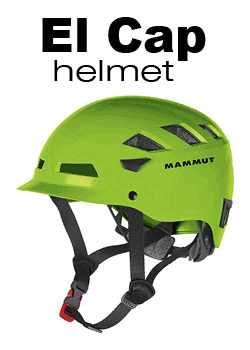
Sponsored Content
Mammut El Cap HelmetA lid with substance and style
The new Mammut El Cap Helmet series combines the latest in technical know-how with style. Its slim-line design and visor gives El Cap a completely new look.
The El Cap is a hybrid helmet. The robust hard plastic outer shell covers the innovative 2K-EPS core - two styrofoam layers of different thicknesses combined together. This core ensures maximum absorption and the highest possible safety level.
Other features include:
- Twelve vents
- Ergonomic interior with comfortable padding
- Fully adjustable headband and chin strap for ideal fit
- 4 headlamp clips
- Standard EN 12492
- UIAA standard 106
- Weight: 350g
- SRP £60.00
- Sizes /colours: 48 – 56cm (white-iron, oak-palau and flash-iron)
- Sizes /colours: 54-62cm (basilic-graphite, smoke-liane, white-iron)
For stockist information call 01625 508218 or visit www.mammut.ch
Logistics
When to Go
Spring and late Autumn are good choices but it completely depends on your heat tolerance, the towers catch a lot of sun.
How to Get There
Ideally Zaragoza (Ryanair), alternatively Reus offers a slight (direct) advantage over Barcelona. However, flights aren't available all year.
Accommodation Advertise here
No Premier Listings found in this area
The obvious place to stay is the local Refugio which can be booked online and offers a variety of board options. The local bar (Bar El Puro) also offers rooms.
Further afield (12-15 mins drive) camping is available in Murillo de Gallego as well as other accommodation.
Van-camping is currently tolerated in the local car park (which gets busy at weekends). Be respectful to ensure it stays that way!
Gear
The majority of the routes require little extra gear although a small rack may be of some use on sparsely bolted pitches (such as the first of Murciana). A small selection of medium nuts and cams should suffice as well as slings for the obvious pebble threads!
A pair of 60m ropes allows for the most flexibility in descent although it is not uncommon to see people using long singles (80m+) to link pitches on the popular steep routes (Biceps). Obviously this severely limits descent options and drag can rapidly become an issue. Watch out as some routes (specifically on El Pison) have crux pitches nearing 50m.
The most popular routes mainly have modern expansion anchors, "parabolts" (often interspersed with older "spits" - 8mm bolts, and even older pegs, "clavos"). Crux pitches are often bolted for aid at a lower grade and on the whole have more bolts than other pitches.
Outdoor Shops Advertise here
No Premier Listings found in this area
Guidebook
A new guide is available entitled "Escalada en los mallos de Riglos " (Felipe Guinda). The previous edition can currently be found in the local shop. Roca Espana Band Sud offers a selection of routes on El Pison and Macizo. Parois de legend (Stéphanie Bodet, Arnaud Petit) offers a selection of topos for a handful of classic routes.
Alternatively, hand drawn topos and photo topos can often be found by simply searching online for your route of choice.
Instructor/Guides Advertise here
No Premier Listings found in this area
Food
The Refugio offers a variety of board options (which includes wine) and food is available in the local bar (Bar El Puro).
Gear and Supplies
There is a small shop next to the parking offering a basic food selection (and alcohol). Supermarkets can be found on the outskirts of Huesca (30-40 mins). A sports shop within the Eroski complex (at the first sight of Huesca from Riglos) has a small climbing department offering the basics. For a wider choice try one of the climbing shops located in Huesca centre.
Other Activities
There are walking trails around the towers, and in the hotter months rafting is available on the Gallego river. Riglos is also popular for base jumping (if that's your thing).
For wildlife enthusiasts there are plenty of opportunities to see Griffon Vultures, Egyptian Vultures and Lammergeier that often circle the towers. Griffon Vultures can be seen perched on ledges close to popular routes.
- First Ascent DVD 19 Dec, 2006



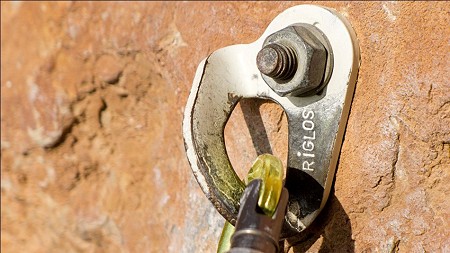

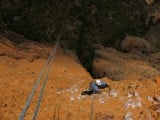
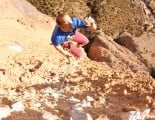
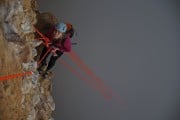

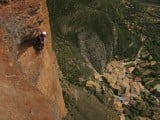
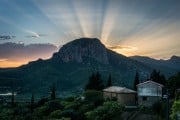











Comments